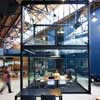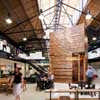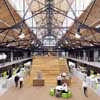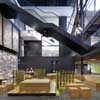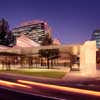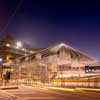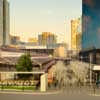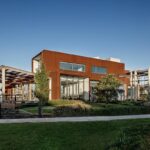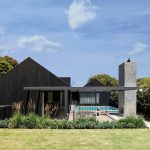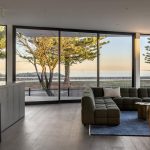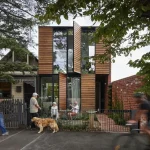Goods Shed, Melbourne Docklands Building, Architect, Collins Street Design
Goods Shed Melbourne
Docklands Building in Victoria design by Elenberg Fraser + BVN Architecture
9 Aug 2010
Goods Shed North
Categories: Interiors and Fit Out – Offices, New and old
Location: Docklands, Melbourne, Australia
Architect: BVN Architecture
WAF Entry: 2010
Award: World Architecture Festival 2010 – Shortlisted
Goods Shed North Building
The refurbishment of the Goods Shed North, in Docklands, a heritage listed railway goods shed, presented an incredible opportunity to renew an integral part of Melbourne Australia’s history.
One of the few heritage buildings left in Docklands, the Goods Shed was originally built in 1889 at the centre of the Melbourne Goods Yards. It was derelict for over 30 years and became redundant in the 1980’s, later being bisected by the Collins Street extension which created the North and South side.
The Good Shed North’s transformation into a vibrant workplace shows what is possible when adaptive reuse of building stock is undertaken with a clear vision and a shared goal. The clients VicUrban, Building Commission & Plumbing Industry Commission (BC/PIC), Equiset as the developer and the consultant team worked in a highly collaborative manner to realise the project both from a tenant perspective and the overarching aim to set a new benchmark for adaptive re-use projects.
“The refurbishment of the Goods Shed North will raise the bar in environmental design by creating an economically feasible sustainable design, incorporating state-of-the-art office accommodation in an historic building,” Victorian Planning Minister Justin Madden said.
Whilst the building’s historical exterior has been restored, the interior has been designed to be an innovative, contemporary, office space. Key historical elements of its interior have been retained whilst incorporating state-of-the-art technology. The design enables the organisations to foster a more innovative and collaborative work ethic through increased visibility and transparency and the creation of both active and passive project spaces within the building’s central zones.
By locating workspaces to the east and west side wings and retaining clear lines of sight through the building’s spine, multifunctional project spaces were created centrally within the base of the voids to ensure greater staff interaction and connectivity. Staff have been quick to engage with the work space, quiet rooms and public spaces, “a hallmark of the incredible success of the design team,” states Pru Sanderson, CEO of VicUrban.
An important aspect of the interior architecture was providing continuity for both clients of our understanding of the eccentricities of the Good Shed North whilst respecting their individual personalities, cultures and organisational requirements.
For VicUrban the underlying principles for this project were to not only create a space that helped foster VicUrban’s desire for an innovative workplace but endeavoured to promote their environmental reputation and strengthen their role as influencers in the local market by delivering a level of excellence in sustainable design.
BC/PIC aspirations were to ensure it’s commitment to inspire, educate and inform both the building and plumbing industries and staff, thus demonstrating their commitment to the environment and showcasing the built environment. The new workplace assisted the joining of two separate organisations, Building Commission and Plumbing Industry Commission with the intent of creating an open and inclusive culture.
The Goods Shed North is a unique heritage building that naturally creates an exceptional backdrop to the workplace, including high ceilings, clerestory windows, exposed trusses, cast iron heritage columns and exposed brickwork. The design aimed to achieve an aesthetic response that built on the existing and reinterpreted elements into a new aesthetic.
Even though a different look and feel for each tenant was created, common elements were used in projects including:
– Selection of environmentally sustainable materials with preference given to products that have eco-preferred content, low embodied energy, recycled content, minimised volatile compound content, and that have minimal amounts of PVC content.
– Minimisation of materials used, minimised use of built space.
– Dominant use of black steel and recycled timber.
– Maintain existing symmetry and structure and clear lines of sight to the full extent of the Goods Shed. Clear glazing to underside of the roof.
– Re-use of existing heritage materials – For VicUrban, old doors taken out of the shed were cleaned and hung as major backdrops to reception. Original slate salvaged from the roof was cleaned and hung in VicUrban as a feature wall. Old tracks were reused for details. And the BC/PIC refurbished an old railway switch from the Shed, which is now on display in their front of house.
– Use of rubber/eco-vinyl flooring in lieu of carpets enhancing ‘warehouse’ aesthetic.
– Mobile and reconfigurable components enable users to adjust spaces, such as, the provision of large sliding panels in lieu of partitions to define spaces for privacy or quiet work, whilst also reducing the quantity of materials used.
Designed to enhance public awareness of sustainable initiatives, Goods Shed North is Victoria’s most sustainable historic building. This is evidenced by the following:
– The interior has been designed to environmental world’s best practice standards.
– The base building has achieved a 5 Star Green Star as designed rating (Australian LEED Certification) +20% carbon reductions ABGR rating.
– Chilled beam and displacement air system.
– Environmentally friendly materials have been used where possible.
– Rainwater harvesting.
– Grey water treatment plant.
– Reduced energy consumption.
– Tri-generation plant.
– Dedicated bike storage, lockers/showers.
– More than 2,400 indoor plants – filters air contaminants.
– Both workplaces have also been designed to be flexible, enabling future adaptation into a retail space.
“Employees from all three Government agencies will directly benefit from this move with improved indoor environmental quality leading to improved health and wellbeing, and corresponding productivity gains.” (Tony Arnel, Chair of both the World Green Building Council and Green Building Council of Australia, and Building and Plumbing Industry Commissioner).
The end result is the creation of Victoria’s most sustainable historic building and a dynamic versatile contemporary workplace that fosters collaboration and innovation. However, the conversation was not without its challenges; namely, the complexity of working within heritage constraints whilst achieving the highest workplace and environmental standards, and considering the building’s future adaptation into retail space.
Previously:
Goods Shed North in Melbourne Docklands
Goods Shed, Docklands, Melbourne, Victoria, Australia
Date built: 2008
Elenberg Fraser / BVN Architecture
Interior fitout : BVN Architecture
Goods Shed North is the recipient of the Property Council of Australia Rider Levett Bucknall Innovation and Excellence Award. The $58 million development of the heritage railway shed Goods Shed North in Melbourne’s Docklands won the 2010 Award for Heritage & Adaptive Reuses.
This particular award recognises excellence in heritage related development or adaptive reuse projects, outstanding conservation projects, adaptive reuse of existing buildings/sites or high-quality infill development within an historic context.
Office and Retail
Planning 2007 / Construction 2008
Client: Pan Equity
Goods Shed – Architect’s Statement
As a gateway to the Docklands, the Goods Shed, a former train freight discharge terminal has undergone a proposal to redesign the space with mixed use, commercial, retail and hospitality tenancies.
The design addresses the position of the shed on the edge of the city through the use of lanterns and sleek roof forms. The shed’s glazed lanterns rise above the Collins Street extension and defi ne the threshold between the CBD and the Docklands, allowing physical and visual links to the Goods Shed. Internally, the “street” runs through the central building atrium, top-lit and luminous. This central focus refl ects the work-place culture and provides social and communicative dimension to office life.
The Goods Shed redevelopment incorporates as many ESD principles where possible in order to give the building a 3.5 star energy rating. The most sustainable, responsible thing that we can do to conserve resources and minimise environmental effects is to reuse our existing structures. To minimise the environmental impact of construction and occupation of the built environment, careful environmental studies must be performed and negative, entrenched practices must be avoided. Elenberg Fraser incorporates environmentally sustainable design principles into our designs.
Goods Shed Melbourne images / information from Elenberg Fraser 190109
Location: Collins Street, Melbourne, Victoria, Australia
Architecture in Melbourne
Melbourne Architecture Designs – chronological list
Melbourne Architect – design studio listings
Another Railway Goods Shed building redevelopment – on e-architect:
Aarhus Northern Goods Railway Project, Denmark
Design: NORD Architects
Goods Shed Building
Comments / photos for the Goods Shed North Australian Architecture page welcome

